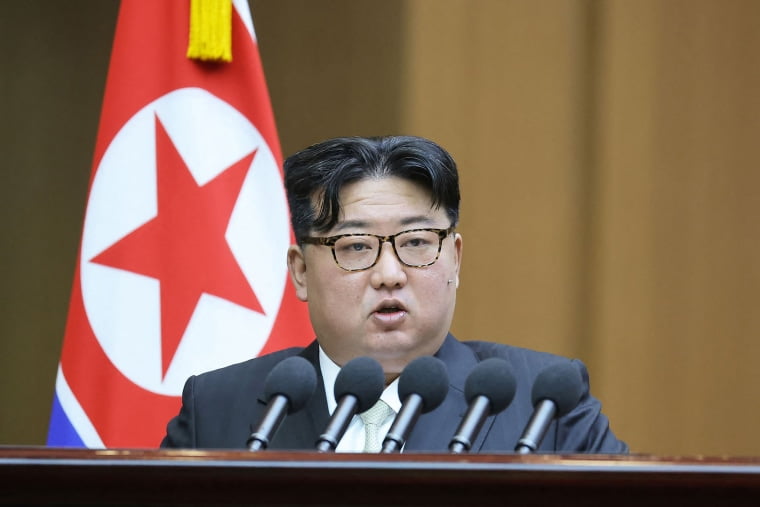Amidst heightened tensions over Kim’s nuclear development and U.S.-South Korea military drills, a momentous decision has been made to abandon a decades-long quest of unification.

Amidst heightened tensions over Kim’s nuclear development and U.S.-South Korea military drills, a momentous decision has been made to abandon a decades-long quest of unification.
The historic decision to abandon a decades-long quest for unification—which was predicated on a shared sense of national homogeneity between the two Koreas—occurs in the midst of heightened tensions, as the speed at which Kim is developing weapons and the South’s military drills with the US have accelerated in lockstep.
During a meeting of the rubber-stamp parliament on Monday, North Korea also eliminated the major government agencies that had been in charge of overseeing relations with South Korea, according to the North’s official Korean Central News Agency.
During a meeting of the rubber-stamp parliament on Monday, North Korea also eliminated the major government agencies that had been in charge of overseeing relations with South Korea, according to the North’s official Korean Central News Agency.
The two Koreas are engaged in a “acute confrontation,” according to the Supreme People’s Assembly, and it would be catastrophic for the North to view the South as a diplomatic ally.
“The Committee for the Peaceful Reunification of the Country, the National Economic Cooperation Bureau and the (Diamond Mountain) International Tourism Administration, tools which existed for (North-South) dialogue, negotiations and cooperation, are abolished,” the assembly said in a statement.
Kim accused the US and South Korea of inciting tensions in the region during an assembly speech. KCNA reported that Kim cited the US and South Korea’s increased joint military drills, the deployment of strategic military assets, and their trilateral security cooperation with Japan as examples of how these actions have turned the Korean Peninsula into a dangerous war-risk zone.
In order to designate South Korea as the North’s “primary foe and invariable principal enemy,” he asked for the assembly to amend the North’s constitution.
In order to designate South Korea as the North’s “primary foe and invariable principal enemy,” he asked for the assembly to amend the North’s constitution.
In order to “completely eliminate such concepts as’reunification,’ “reconciliation,” and “fellow countrymen” from the national history of our republic,” he also ordered the elimination of historical emblems of inter-Korean reconciliation.
In particular, he called for the removal of an ugly monument in Pyongyang that celebrated the goal of reunification and the closure of parts of cross-border railways.
“We cannot travel the path of national restoration and reunification together; this is the ultimate conclusion drawn from the bitter history of the inter-Korean relations,” he declared.
During a Seoul Cabinet meeting, South Korean President Yoon Suk Yeol stated that Kim’s remarks demonstrate the Pyongyang government’s “anti-national and anti-historical” stance. Yoon declared that the South would punish the North “multiple times hard” if it provoked it and that it was still keeping a robust defense posture.
During a Seoul Cabinet meeting, South Korean President Yoon Suk Yeol stated that Kim’s remarks demonstrate the Pyongyang government’s “anti-national and anti-historical” stance. Yoon declared that the South would punish the North “multiple times hard” if it provoked it and that it was still keeping a robust defense posture.
Yoon declared that the North’s “fake peace tactic, which threatened us to choose between ‘war’ and ‘peace,’ no longer works.”
During his statement to the assembly, Kim restated that while the North does not intend to initiate a war on its own, it also does not intend to avoid one. He claimed that a nuclear war on the Korean Peninsula would bring about South Korea’s demise and cause “unimaginable disaster and defeat to the United States,” citing his expanding military nuclear program.
The assembly said that the government of North Korea will put the decision to dissolve the agencies in charge of communication and collaboration with the South into effect by taking “practical measures.”
Since its founding in 1961, the National Committee for Peaceful Reunification has served as North Korea’s principal organization for managing inter-Korean issues.
These initiatives, which included tours of South Korea to the North’s Diamond Mountain resort and a cooperatively run factory park in the border town of Kaesong, have been put on hold for years as tensions between the adversaries have escalated over North Korea’s nuclear aspirations.
These initiatives, which included tours of South Korea to the North’s Diamond Mountain resort and a cooperatively run factory park in the border town of Kaesong, have been put on hold for years as tensions between the adversaries have escalated over North Korea’s nuclear aspirations.
Connect with us for the Latest, Current, and Breaking News news updates and videos from thefoxdaily.com. The most recent news in the United States, around the world , in business, opinion, technology, politics, and sports, follow Thefoxdaily on X, Facebook, and Instagram .
